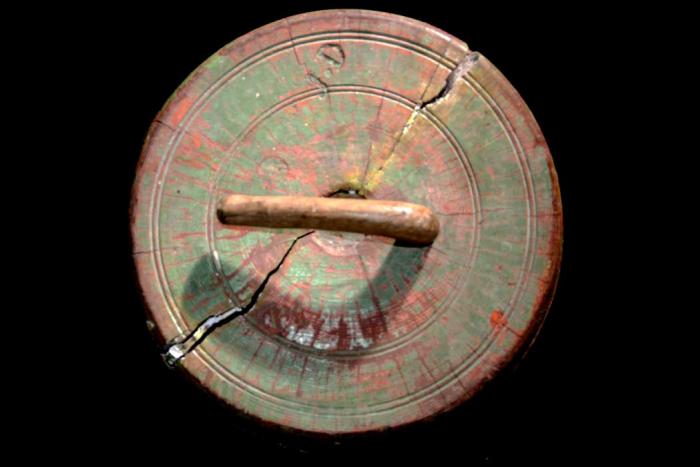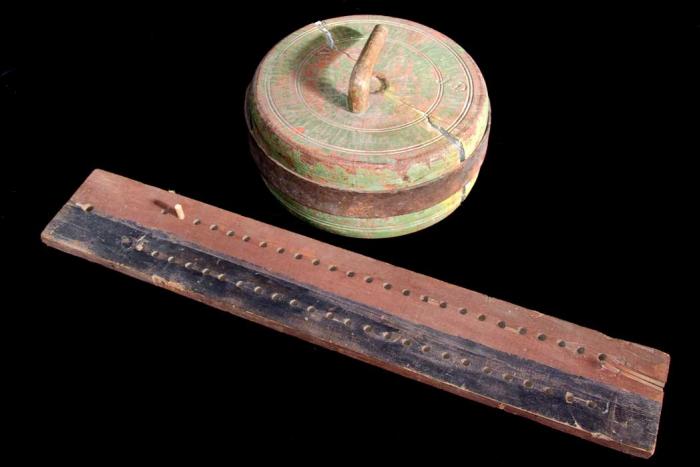Curling Block
Organization: Chateauguay Valley Historical Society
Coordinates: http://www.rootsweb.ancestry.com/~qcchatea/cvhs.htm
Address: 2860 Rivière aux Outardes, Ormstown, QC J0S 1K0
Region: Montérégie
Contact: Carolyn Cameron, carolyn(a)abccameron.com
Description: Wooden curling block used to play the game of curling on Templeton’s Pond, Scotch Concession, Riverfield, Quebec in the 19th century. It is marked “JD” for the owner of the item, James Davis, an original settler of the Scotch Concession.
Year made: 1886
Made by: Charles Abbot
Materials/Medium: Probably beech wood, iron
Colours: Natural
Provenance: Howick, Quebec
Size: 34.2 cm x 15.8 cm
Photos: Rachel Garber. Courtesy Chateauguay Valley Historical Society
The Curling Block
Carolyn Templeton Cameron
Curling has a long history among the Scottish settlers in Quebec. According to Ann Craig’s diary, dated January 1, 1823, “Was a good day and they were curling on the loch and Ann Walker came up at night.” On the third of April of the same year, the Craig family sailed from Greenock, Scotland, to Canada, arriving in Montreal on May 22, 1823. They went by boat to Beauharnois and then walked through the bush to Ste. Martine, and south to what became the eastern end of the Scotch Concession, near present day Howick, Quebec. Here the Craig's had relatives who had preceded them and they began to carve out a life in the wilderness.
Of course like any new immigrant to this country, the Craig's and other Scottish families who had settled near them clung to the customs of their homeland. In the winter of 1825, the ice was in such prime order, that James Davis, a keen curler in Scotland, thought it a pity that it should be allowed to pass unused. He proposed to William Miller that they should have a game. They made blocks of wood (probably beech wood), and went to the creek and had the first gemm played in the district, of which Miller was the winner. Both men lived on the Scotch Concession.
Curling had been introduced to Canada probably by Scottish soldiers after the Conquest of 1763.They saw that the long winters and thicker ice made Canada a natural place for the game. Lacking the granite stones of Scotland however, they were forced to improvise and are credited with the introduction of the “iron”stones, supposedly made with melted down cannon balls.
According to Wayne McKell in the 1994 Chateauguay Valley Historical Journal, irons were used by the twenty prominent Montreal Scottish businessmen who formed the Montreal Curling Club on January 22, 1807, following one of their games on the St. Lawrence River. This club, which became the Royal Montreal Curling Club, is the oldest sports club in North America.
The ease with which the Scotch Concession men came up with the idea of using wooden “stones” suggests that others before them may have come up with this ingenious solution. At any rate, the idea spread and the first curling in almost every region of Canada was with the wooden blocks. The word “block” is still used in reference to a curling stone today.
The Scotch Concession men formed the Lansdown Curling Club and curled on Templeton’s pond. Robert Templeton had immigrated from Scotland in 1829 and enjoyed the roaring game along with his curling aficionado neighbours, James Davis and William Miller.
In the earliest days of the game, everyone had two of their own blocks, each one individually shaped and probably homemade. In 1885, the English River Club built a curling rink that became a very active place. The Lansdown Club had just had a new set of wooden blocks made to a uniform weight and size by Charles Abbot, a Howick carpenter. On January 22, 1886 the Lansdown Club defeated the English River Club “for the first time in many years” by a score of 20-15.These new uniform blocks seemed to have given Lansdown an advantage over English River. The Lansdown teams consisted of James Davis Sr., James Templeton, William Templeton, and William Carmichael, who was the skip, with the second team of Joseph McLeod, William McLeod, John James Metcalfe, and James Miller, as the skip. It should be noted that James Davis Sr. was still curling in 1886, although no longer the skip of the team and presumably of considerable age.
The Lansdown Curling Club disbanded soon after this impressive victory and the curlers all began to enjoy the rival English River Club’s indoor ice rink facility. It would seem curling on Templeton’s pond was over, or was it? In the 1920s and 1930s, Wallace Templeton’s five sons had many happy times playing on the pond in front of their house. The curling blocks came out of the granary and once again there was curling on the pond. All five of the boys including Jim, Doug, Donald, Earle, and Murray, became members of English River Curling Club, playing at first on natural ice and then later on artificial ice. “Senior” curling gave them all many enjoyable afternoons at “the rink.”
The Chateauguay Valley curling block is the only remaining stone from Templeton’s granary, now owned by Alec Templeton, a sixth generation member of the Templeton family. It has the initials “JD” carved into the top, representing the name James Davis, who brought his love for the game with him from Scotland. What a lifelong contribution he made to curling and sport in Canada!
The block itself is probably made of beech and measures 34.2 cm across by 15.8 cm in height with an iron band 5 cm wide holding it together. The handle, which is only a crooked branch from a tree, is beautifully fastened into the block. This curling stone represents the ingenuity of the Scottish people who came to the Chateauguay Valley in Quebec. They used something that was readily available to make blocks for a moment of leisure and fun on the ice in the dead of winter.
In the 1800s it was strictly a man’s game and it was not until the second decade of the 1900s that women began to show interest in curling too. In the 1930s, women became indispensable to the financial success of curling clubs as they raised money by holding euchre parties, oyster suppers, ham suppers and New Year’s Eve dances.
The sport of curling has taken people in many directions. It has had an impact on the local social scene, with many romances resulting from first meetings at a mixed “bonspiel” or curling tournament. It has also given curlers the opportunity to travel to other areas of Quebec and Canada to enjoy a friendly game. What began as a game of the “old countrymen” has become an integral part of the sports scene in Quebec.
Sources
Ann Craig, Personal Diary from April 1822 to December 1825. Chateauguay Valley Historical Society collections.
Jean Furcall, oral history interview 2012.
Wayne McKell, “Curling and the Valley,” Chateauguay Valley Historical Journal, 1974.
Wayne McKell, Riverfield Curling Club 1825-1975: An Historical Sketch, 1975.
Robert A. Sellar, History of the County of Huntingdon and the Seigneuries of Chateauguay and Beauharnois, 1888.
To Learn More
Canadian Curling Association, www.curling.ca
Library and Archives Canada, www.collectionscanada.ca
Maxwell L. Howell and Nancy Howell, Sports and Games in Canadian Life 1700 to the Present, 1969.
Author
Carolyn Templeton Cameron is a member of the Chateauguay Valley Historical Society.










Add new comment